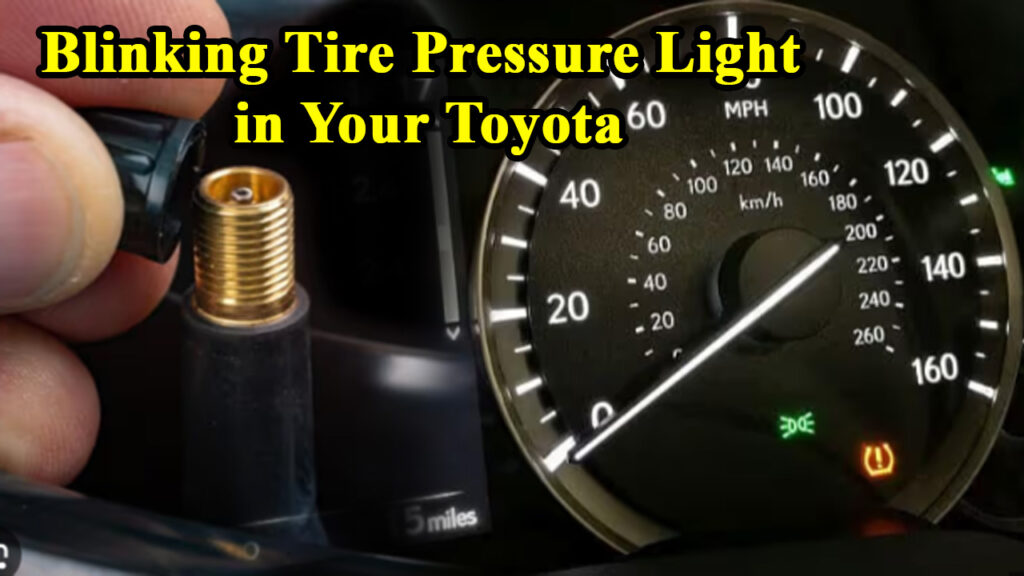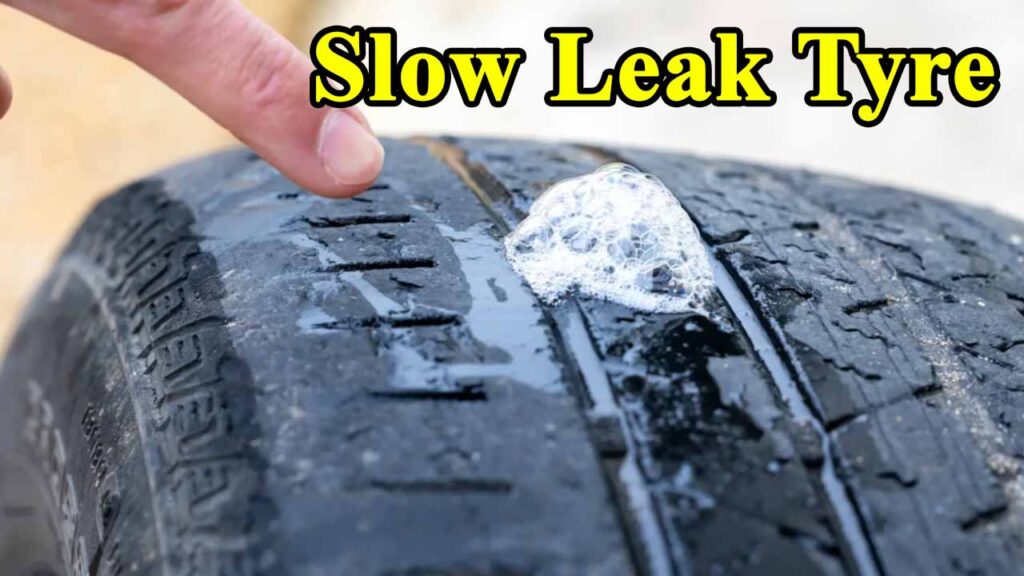Before we tackle the blinking light, let’s briefly grasp what the TPMS does. Modern vehicles, including your reliable Toyota, are equipped with a sophisticated Tire Pressure Monitoring System. This system uses sensors, typically located inside each tire (including the spare in some models), to constantly monitor the air pressure. Its primary goal? To enhance your safety by alerting you when a tire’s pressure falls below a safe threshold, which can lead to poor handling, reduced fuel efficiency, and even a dangerous blowout.
When your TPMS light illuminates solidly, it’s usually a straightforward message: “Check your tire pressure, it’s low!” But when it starts blinking, that’s a different beast entirely. It signifies that there’s a malfunction within the TPMS system itself, preventing it from accurately monitoring your tire pressures. Think of it as the messenger itself being unwell, rather than just delivering a low-pressure note.
Why Your Toyota’s Tire Pressure Light Might Be Blinking
A blinking TPMS light on a Toyota can stem from several causes. Based on countless hours of diagnosis and real-world experience, here are the most common culprits:
-
Dead or Failing TPMS Sensor Battery: This is, without a doubt, the most frequent reason for a blinking light. Each TPMS sensor has a small, non-rechargeable battery. These batteries typically last anywhere from 5 to 10 years, depending on usage and environmental factors. Once the battery dies, the sensor can no longer transmit pressure data to the vehicle’s computer, causing the system to register a fault and trigger the blinking light. It’s similar to your phone’s battery dying – it just stops communicating.
-
Faulty or Damaged TPMS Sensor: While less common than a dead battery, a sensor can be physically damaged. This often happens during tire mounting or balancing, or if you hit a particularly nasty pothole – something we’re all too familiar with on some of the rural roads around Cheney. A damaged sensor simply can’t send reliable data, leading to a system error.
-
TPMS System Malfunction (Control Module Issues): The TPMS sensors communicate with a central control module in your Toyota. If this module experiences an internal fault, it can disrupt the entire system, causing the blinking light. This is a rarer but more complex issue, often requiring professional diagnosis.
-
Incorrect TPMS Sensor Installation or Programming: If you’ve recently had new tires installed or even just a tire rotation, and the light starts blinking afterward, it could be that the sensors weren’t properly reprogrammed or “relearned” by the vehicle’s computer. Each sensor has a unique ID, and the car needs to know which sensor is where. Sometimes, tire shops might not have the correct tools or expertise to properly pair the new sensors with your Toyota’s system, especially if they aren’t specifically trained on Toyota’s TPMS.
-
Extreme Temperature Fluctuations: While typically causing a solid light due to actual pressure changes, drastic and sudden drops in temperature (like those surprisingly cold Kansas mornings in late fall or early spring) can sometimes confuse the TPMS system, leading to a temporary blinking light. As air condenses in colder temperatures, tire pressure drops, and if the system registers a significant, rapid change, it might temporarily signal a fault.
-
Aftermarket Wheels or Tires Without Compatible TPMS Sensors: If you’ve swapped out your original wheels for aftermarket ones, or if replacement tires were installed without transferring or installing new, compatible TPMS sensors, your system will naturally blink because it can’t detect the necessary sensors.
The Real-World Impact: Why You Shouldn’t Ignore It
Ignoring a blinking TPMS light isn’t just about tolerating an annoying dashboard indicator. It means your primary tire pressure monitoring system is compromised. This is a significant safety concern. You lose the automatic warning system that could alert you to a developing flat tire or dangerously low pressure. This could put you and your passengers at increased risk of:
- Tire Failure: Underinflated tires generate excessive heat, increasing the risk of a blowout, especially at highway speeds.
- Reduced Handling and Braking: Proper tire pressure is crucial for optimal vehicle control. Low pressure can lead to sluggish steering and longer braking distances.
- Decreased Fuel Efficiency: Underinflated tires create more rolling resistance, meaning your engine has to work harder, consuming more fuel. Over time, this adds up at the pump.
- Uneven Tire Wear: Improper inflation can cause tires to wear out prematurely and unevenly, leading to costly replacements.
I remember a client who came into the shop a few years back, driving a well-maintained Toyota Camry. They’d been ignoring a blinking TPMS light for weeks, thinking it was “just a glitch.” Turns out, one of their TPMS sensor batteries had died, and they’d been unknowingly driving on a tire that was significantly underinflated due to a slow leak. They were lucky they didn’t experience a blowout on their daily commute between Wichita and Hutchinson. This incident underscored the importance of addressing even a blinking light promptly.
Beyond the Tread: A Deep Dive into the Enduring Legacy of L&M Tire
Troubleshooting and Fixing the Blinking Light
So, what do you do when your Toyota’s TPMS light starts blinking? Here’s a systematic approach:
1. Check Tire Pressure Manually (Crucial First Step!)
Even if the light is blinking, always start by manually checking the air pressure in all four tires (and your spare, if applicable) using a reliable tire pressure gauge. Inflate them to the manufacturer’s recommended PSI, which you’ll find on a sticker inside your driver’s side door jamb or in your owner’s manual. Sometimes, a very low tire, even if the sensor is otherwise working, can trigger the blink.
- Personal Tip: I always recommend checking tire pressure when the tires are cold (before driving for the day). Driving heats up the tires, which increases internal pressure, giving you an inaccurate reading.
2. Attempt a TPMS Reset
Toyota vehicles often have a TPMS reset button. The location can vary by model and year, but it’s typically found under the steering wheel, in the glove box, or on the dashboard.
General Reset Procedure (Consult your owner’s manual for exact steps for your model!):
- Park your Toyota and turn the engine off.
- Turn the ignition to the “ON” position (without starting the engine).
- Locate the TPMS reset button.
- Press and hold the reset button until the TPMS indicator light blinks three times.
- Release the button.
- Start the engine and drive for about 10-20 minutes at speeds above 20-30 mph. This allows the system time to “relearn” and register the sensor data.
If the issue was a temporary communication glitch or a slight pressure discrepancy that was rectified, the light might turn off and stay off.
3. Consider Cold Weather Effects
If the blinking started on a particularly cold day, inflate your tires to the recommended PSI, drive for a bit to warm them up, and then see if the light resolves itself. If it persists, move on to the next steps.
4. When to Seek Professional Help
If the light continues to blink after checking pressures and attempting a reset, it’s time to visit a trusted mechanic or Toyota dealership. Here’s why:
- Diagnosing Sensor Failure: A professional will use a specialized TPMS scan tool to communicate with each sensor and the control module. This tool can identify which specific sensor is faulty, whether its battery is dead, or if there’s a communication error.
- Sensor Replacement: If a sensor is dead or faulty, it will need to be replaced. This involves dismounting the tire, installing the new sensor, and then properly programming it to your vehicle’s TPMS computer.
- Cost Insight: The cost of a new TPMS sensor itself for a Toyota typically ranges from $25 to $75 per sensor for aftermarket parts, and potentially $50 to $100+ for OEM Toyota parts. Labor to install and program a single sensor can add another $50 to $150, depending on the shop and location. So, for one sensor, you’re looking at a total cost anywhere from $75 to $225. It’s often recommended to replace all sensors if they are of similar age, as batteries tend to die around the same time.
- Module Diagnosis and Repair: In rare cases, if the issue is with the TPMS control module, a dealership or specialized shop will be equipped to diagnose and repair or replace it. This is usually the most expensive repair.
Case Study: The Blinking Light After a Tire Rotation
A common scenario I encounter is a blinking TPMS light right after a tire rotation. Just last month, a gentleman from Garden Plain brought in his older Toyota RAV4, complaining of a blinking light that appeared immediately after he had his tires rotated at a chain store. He was frustrated because his tires were perfectly inflated.
Using our diagnostic scanner, we found that while the shop had rotated the tires, they hadn’t performed the necessary TPMS “relearn” procedure. The vehicle’s computer was still looking for the front sensors in the front positions, but they were now in the back, leading to a communication error and the blinking light. A quick relearn procedure, which involves driving the vehicle for a specific duration or using a scan tool to re-register the sensor positions, resolved the issue in minutes. This highlights the importance of going to a shop that understands the nuances of your vehicle’s systems.
Important Values and Originality
When it comes to automotive care, especially for critical safety systems like TPMS, value isn’t just about the lowest price. It’s about:
- Accuracy: Ensuring the diagnosis is correct the first time.
- Expertise: Having technicians who deeply understand Toyota’s specific TPMS protocols.
- Trustworthiness: Knowing that you’re getting a genuine repair with quality parts, and not being sold unnecessary services.
My goal in sharing this detailed information is to empower you, the Toyota owner, with the knowledge to approach this issue confidently. Don’t fall for generic advice; your Toyota’s TPMS system has its own quirks and requirements.
Personal Touch: My Own TPMS Experience
I distinctly remember a few years ago when the TPMS light on my personal Toyota Tacoma started blinking. It was a cold December morning, and I had just finished my usual pre-drive check of fluids and tires. I thought, “Could it be a dead sensor already?” I’d had the truck for about seven years at that point.
I pulled out my trusty tire gauge – an old-school mechanical one, the kind that never needs batteries – and confirmed all my tires were at the recommended 30 PSI. I then tried the reset procedure (mine involved turning the key to “ON,” pressing and holding the button under the dash for a few seconds until the light blinked, and then driving for about 15 minutes). Nothing. The light kept on blinking.
That’s when I knew it was likely a dead sensor battery. I took it to my own shop, hooked up the scanner, and sure enough, the front passenger side sensor reported a “low battery” fault code. We replaced it, ran the relearn procedure, and the blinking light vanished. It was a simple fix, but without the diagnostic tool, it would have been a guessing game. It reinforced to me that even with all my experience, sometimes you need the right tools to confirm the problem.
Conclusion: Don’t Let That Blinking Light Keep You Guessing
A blinking tire pressure light on your Toyota isn’t just a random flicker; it’s a critical communication from your vehicle’s safety system. By understanding what it means, the common causes, and the appropriate steps to take, you can ensure your Toyota remains safe, efficient, and reliable.
While a quick reset or a simple tire inflation might do the trick, don’t hesitate to seek professional help if the light persists. Investing in a proper diagnosis and repair of your TPMS is an investment in your safety and the longevity of your tires. So, the next time that blinking light appears, you’ll know exactly what to do – and you can drive with peace of mind, whether you’re navigating the streets of Cheney or venturing further afield.
FAQ: Your Blinking TPMS Light Questions Answered
Q1: Is it safe to drive with a blinking TPMS light? A1: While your tires might be properly inflated, a blinking TPMS light indicates a fault in the system itself. This means you’ve lost the crucial automatic warning system that alerts you to low tire pressure. It’s advisable to have it checked as soon as possible to restore this safety feature.
Q2: How long do TPMS sensor batteries usually last in a Toyota? A2: TPMS sensor batteries in Toyotas typically last between 5 to 10 years, depending on factors like driving habits, mileage, and climate. If your vehicle is in that age range, a dead sensor battery is a very likely culprit for a blinking light.
Q3: Can I replace a TPMS sensor myself? A3: While you might be able to physically replace the sensor if you have the right tools to dismount and remount a tire, the tricky part is programming or “relearning” the new sensor to your Toyota’s computer. This often requires specialized TPMS scan tools that most DIYers don’t have. It’s usually best left to a professional to ensure it’s done correctly.
Q4: Will a tire rotation cause the TPMS light to blink? A4: Not directly, but it can. If the TPMS sensors aren’t properly reprogrammed or “relearned” after a tire rotation, the vehicle’s computer might not recognize the new positions of the sensors, leading to a communication error and a blinking light.
Q5: What’s the difference between a solid TPMS light and a blinking one? A5: A solid TPMS light typically means one or more of your tires has low air pressure and needs to be inflated. A blinking TPMS light indicates a malfunction within the TPMS system itself (e.g., a dead sensor battery, faulty sensor, or communication issue), meaning the system isn’t able to accurately monitor tire pressure.




